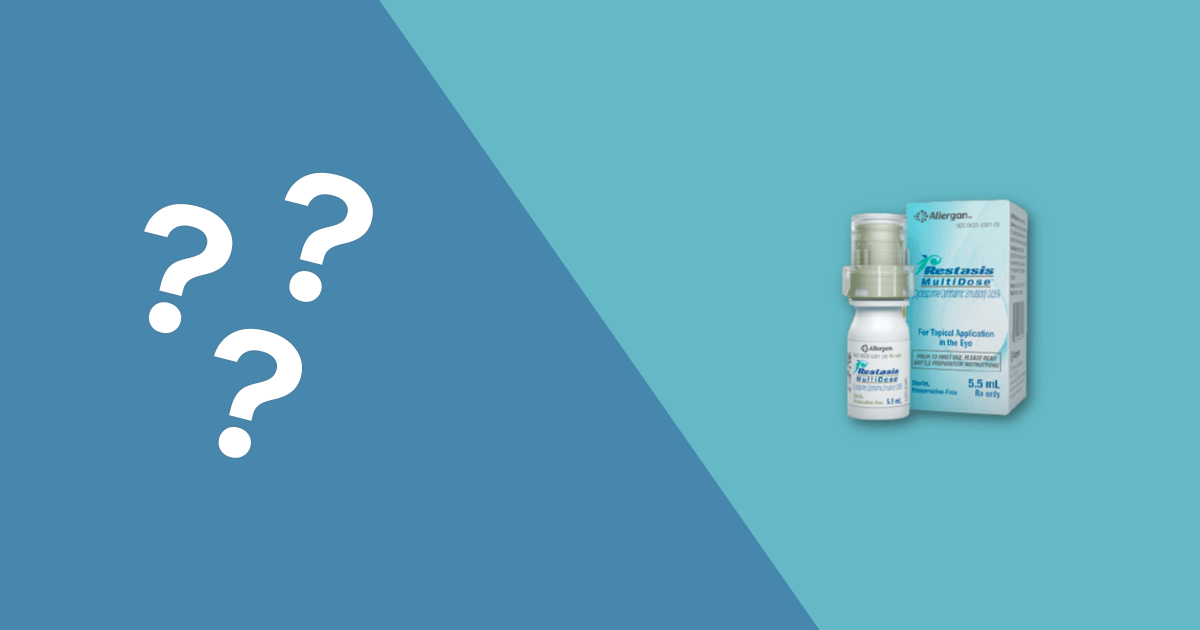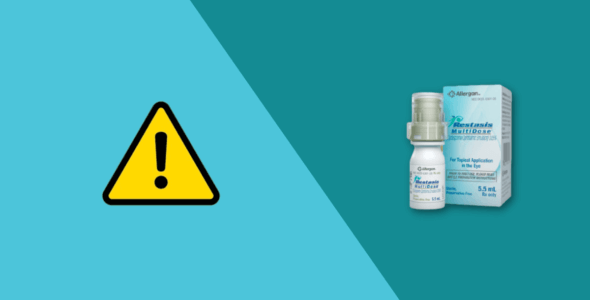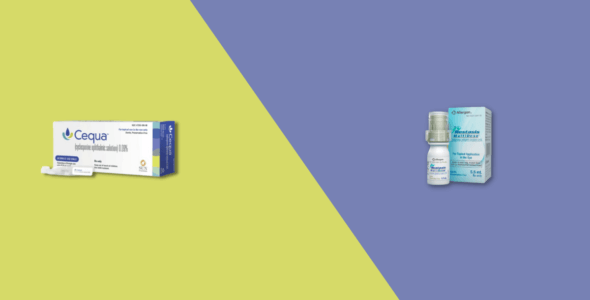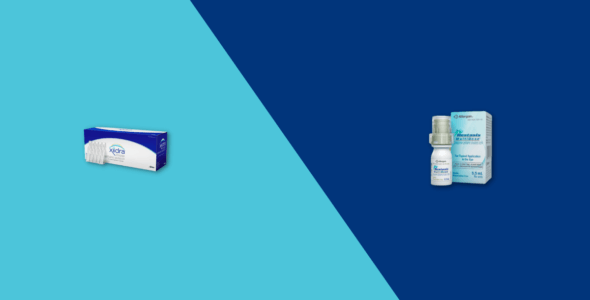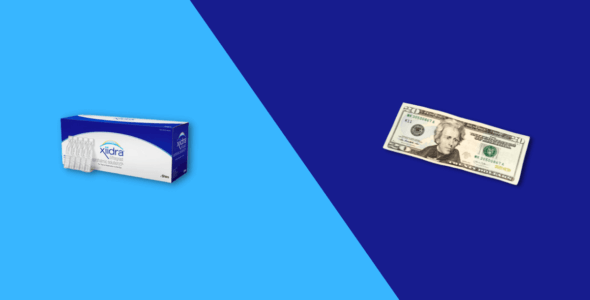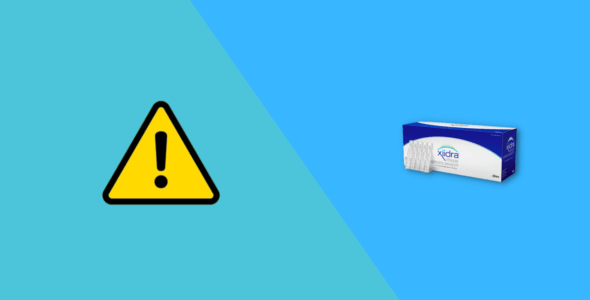Restasis alternatives: which other medications can I take?
Table of contents
Restasis is an FDA-approved (U.S. Food and Drug Administration) brand-name medication manufactured by Allergan, Inc. Restasis eye drops are used to treat chronic dry eye disease that may be caused by inflammation. It is a topical immunomodulator indicated to increase tear production in patients whose tear production is presumed to be suppressed due to ocular inflammation associated with keratoconjunctivitis sicca. Increased tear production is not seen in patients taking topical anti-inflammatory drugs or using punctual plugs.
The active ingredient of Restasis is cyclosporine. This substance belongs to a class of drugs that suppress the immune system, leading to an increase in natural tears.
We will look at what Restasis is, what it’s used for, its side effects, interactions, the precautions you should take when using it, and the alternative treatments available.
Restasis dosage
Restasis is available as an ophthalmic emulsion formulation containing cyclosporine 0.5mg/mL. It comes in two forms: single-use vials and Restasis multidose.
Instill one drop of Restasis twice a day in each eye, every 12 hours. Throw the single-use vial away after you use it as the vials don’t contain any preservatives.
Wait at least 15 minutes before using any artificial tears or any other eye drops. Do not touch the dropper on any surface, including the eyes or hands. The dropper is sterile. If it becomes contaminated, it could cause an eye infection. Also, to avoid potential eye injury and contamination, be careful not to touch the vial tip to your eye.
Do not use this medicine while wearing contact lenses. Contact lenses may be reinserted 15 minutes after administering Restasis eye drops. Store at room temperature, away from moisture and heat. Do not freeze, and keep the bottle tightly closed when not in use.
You are advised to read the medication guide provided with this medicine for drug information and patient information. Always speak with your healthcare provider for medical advice about any changes to your dose so they can monitor and evaluate your condition.
What are the side effects of Restasis?
The most common side effects of Restasis in clinical trials include the following:
- Instillation site pain
- Conjunctival hyperemia (inflammation of the conjunctiva)
- Mild eye pain, redness
- Ocular burning sensation
- Eye irritation, eyelid inflammation (blepharitis)
- Headache
- Urinary tract infection
- Blurred vision
If you experience any of these serious side effects, stop taking Restasis and seek medical attention immediately. You are encouraged to report the negative side effects of prescription drugs to the FDA. Visit www.fda.gov/medwatch, or call 1-800-FDA-1088.
Restasis drug interactions
There is currently no data available for Restasis interactions with other medications. Tell your healthcare provider about all the medicines you take, including other eye medications, prescription drugs, over-the-counter medicines, vitamins, and herbal supplements.
Restasis warnings & precautions
You should not use Cequa if you:
- Are allergic to the active ingredient cyclosporine
- Have had an allergic reaction to any of the other ingredients in Cequa
- Are younger than 16 years old
Talk to your doctor before using Cequa if you:
- Are taking any of the medications that could interact with Cequa
- Are pregnant or are planning to become pregnant
- Are breastfeeding or are planning to breastfeed
You should always check with your doctor or pharmacist before taking any medication, including Restasis, to make sure it is safe for you.
Alternatives to Restasis for dry eyes
Alternatives to Restasis for dry eyes include brand-name medications such as Cequa, Xiidra, and Systane and non-branded medications (generics) such as cyclosporine.
Restasis vs cyclosporine
Restasis eye drops are available in the U.S. as generic cyclosporine ophthalmic eye drops. The generic version was approved in February 2022 and is available as a 0.05% strength (the same as Restasis) in quantities of 30 or 60 single-dose vials. The generic version may be used for the same conditions as Restasis and is just as effective and safe.
Cequa vs Restasis
Cequa is a brand-name eye drop also used for the treatment of dry eye syndrome, a disease of the tears and ocular surface. Neither Cequa nor Restasis are steroid eye drops.
Cequa ophthalmic solution is manufactured by Sun Pharmaceutical Industries, Inc. It is classed as a calcineurin inhibitor immunosuppressant used to increase tear production in patients with keratoconjunctivitis sicca. The active ingredient of Cequa is also cyclosporine which suppresses the activation and function of T-lymphocytes, preventing cell death.
Cequa is available as a cyclosporine ophthalmic solution in preservative-free single-use vials, in doses of 0.9 mg/mL, and is used in the same way you would use Restasis. The side effects and contraindications for Cequa are similar to those for Restasis.
In terms of a cost comparison, Cequa ophthalmic solution 0.09% will cost around $560 for 60, and Restasis ophthalmic emulsion 0.05% will cost around $330 for 30 emulsions.
RELATED: Cequa vs Restasis
Xiidra vs Restasis
Xiidra is also a prescription drug used for the treatment of dry eye syndrome. Xiidra is an FDA-approved prescription eye drop manufactured by Novartis Pharmaceuticals Corporation. Xiidra contains lifitegrast a lymphocyte function-associated antigen-1 (LFA-1) antagonist used to treat the signs and symptoms of dry eye disease (DED) or blepharitis. Xiidra reduces the symptoms of eye dryness and may provide lasting symptom relief.
Xiidra is available as a 5% (50 mg/mL) ophthalmic solution and is used twice daily in the same way you would use Restasis. Side effects of Xiidra are similar to those of Restasis but with the added side effect of dysgeusia (an unusual taste in the mouth). As a guide, Xiidra ophthalmic solution 5% will cost around $590 for 60 mL.
RELATED: Xiidra vs Restasis
Are Restasis and Xiidra the same?
Restasis and Xiidra are not the same. Restasis contains cyclosporine, an immunosuppressive agent, and Xiidra contains lifitegrast, a lymphocyte function-associated antigen-1 antagonist. They have different mechanisms of action for the treatment of dry eye disease.
Is there an over-the-counter alternative to Restasis?
There are a number of over-the-counter alternatives to Restasis available for the treatment of dry eye disease. These include Systane, Artificial Tears, Refresh Tears, Tears Naturale, and HypoTears.
Is there a generic version of Restasis?
Restasis is the trademark brand name for cyclosporine manufactured by Allergan Inc. A generic version of cyclosporine is available. Generic drugs are generally cheaper than brand-name drugs.
What medication do you use to treat dry eye?
The medication you use to treat dry eye disease will depend on the cause. Artificial tears, available without a prescription, are the most common types of treatment for mild dry eye. More severe dry eye conditions may be treated with prescription medications such as Restasis or Cequa (cyclosporine), or Xiidra (lifitegrast). These treatments help to improve tear production by the eye itself.
Non-medication treatments may also be suggested, such as avoiding smoke, or air-conditioned rooms, using humidifiers to keep the air moist, limiting time spent in front of computer screens, using sunglasses, and ensuring you keep hydrated and getting enough sleep can all help with limiting dry eye problems.
Other alternatives, more radical treatment options may include tear duct plugs to stop tears from draining from your eyes or even surgery to help keep tears in your eyes. Speak to your doctor or ophthalmologist for advice as to the best treatment for you.
Medically reviewed
A medical professional has reviewed this article.


Jamie Winn, PharmD
Jamie Winn, PharmD
Dr. Jamie Winn received his Doctor of Pharmacy in 2002 from the University of South Carolina College of Pharmacy, Columbia, SC. Jamie is a medical reviewer for NiceRx.

